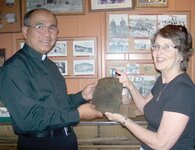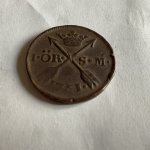pegleglooker
Bronze Member
- Jun 9, 2006
- 1,857
- 237
- Detector(s) used
- ace 250
- Primary Interest:
- All Treasure Hunting
Mission Bell Fragment Finds Its Way Home

One story tells that the Indians bartered for the bells in Mexico and brought them to the mission. Another more colorful story explains that the mission founders collected jewelry and trinkets from the natives and sent it to Spain to be melted and made into bells as symbols of their conversion to Christianity.
Since the summer of 1926, the mystery of the lost bells of the Santa Ysabel Asistencia has been the stuff of rumor and conflicting stories, pitting groups of people against each other. The Indians thought the white ranchers stole them for the gold; the ranchers thought the Indians stole them to make the ranchers look bad.
In July of 2012, Kathleen Frazee of the Center for Oral and Public History, California State University, Fullerton, visited Father Cecilio Moraga, pastor of the mission, to return a piece of one of the missing bells and to fill in part of the puzzle of the bells’ whereabouts for the last 86 years.
Helen Smith, a historian, recorded an interview in the mid-1970s with the son of a Redlands garage owner that tells another part of the tale. According to the transcript of Smith’s interview, the garage owner had a good friend, an Indian named Fig Tree John from Palm Springs. Fig Tree had some young friends who had metal they wanted assayed. As a favor to Fig Tree, the garage owner unwittingly took the stolen bells from three young Indians, which by then were nothing more than a gunnysack full of metal parts, to have them assayed. When the garage owner reported to Fig Tree that it was a composite of 40 different types of metal, Fig Tree thanked him and said the young men would come to retrieve it.
Months passed and the men never returned. The garage owner pressed Fig Tree and learned that they had no interest in the metal, which was stolen, if there was no gold. In a quandary, the garage owner could neither dispose of the bells nor return them. He kept the sack in his garage for decades. Eventually, he offered the bells to his son, who took a couple of pieces.
In 1965, based on a photo in a book about mission bells, the son recognized the pieces as the lost bells from Santa Ysabel. He contacted the mission and returned a piece that has since been on display at the museum. Afraid of recriminations, his father refused to part with the gunnysack of bells.
When Smith died in 1984, her daughter donated her work to the university at Fullerton. When funding became available, the Center for Oral and Public History Office transcribed Smith’s interview. Inspired by the story, Frazee searched and found the widow of the man who had been interviewed, who agreed to return the piece of the bell still in her possession.
When Father Moraga announced the return of the missing bell fragment at mass, an audible gasp filled the chapel. Tears welled up in the eyes of a descendant of a ranching family thought to have been involved in the theft — her family name was no longer under suspicion.
Courtesy of Mission Bell Fragment Finds Its Way Home

One story tells that the Indians bartered for the bells in Mexico and brought them to the mission. Another more colorful story explains that the mission founders collected jewelry and trinkets from the natives and sent it to Spain to be melted and made into bells as symbols of their conversion to Christianity.
Since the summer of 1926, the mystery of the lost bells of the Santa Ysabel Asistencia has been the stuff of rumor and conflicting stories, pitting groups of people against each other. The Indians thought the white ranchers stole them for the gold; the ranchers thought the Indians stole them to make the ranchers look bad.
In July of 2012, Kathleen Frazee of the Center for Oral and Public History, California State University, Fullerton, visited Father Cecilio Moraga, pastor of the mission, to return a piece of one of the missing bells and to fill in part of the puzzle of the bells’ whereabouts for the last 86 years.
Helen Smith, a historian, recorded an interview in the mid-1970s with the son of a Redlands garage owner that tells another part of the tale. According to the transcript of Smith’s interview, the garage owner had a good friend, an Indian named Fig Tree John from Palm Springs. Fig Tree had some young friends who had metal they wanted assayed. As a favor to Fig Tree, the garage owner unwittingly took the stolen bells from three young Indians, which by then were nothing more than a gunnysack full of metal parts, to have them assayed. When the garage owner reported to Fig Tree that it was a composite of 40 different types of metal, Fig Tree thanked him and said the young men would come to retrieve it.
Months passed and the men never returned. The garage owner pressed Fig Tree and learned that they had no interest in the metal, which was stolen, if there was no gold. In a quandary, the garage owner could neither dispose of the bells nor return them. He kept the sack in his garage for decades. Eventually, he offered the bells to his son, who took a couple of pieces.
In 1965, based on a photo in a book about mission bells, the son recognized the pieces as the lost bells from Santa Ysabel. He contacted the mission and returned a piece that has since been on display at the museum. Afraid of recriminations, his father refused to part with the gunnysack of bells.
When Smith died in 1984, her daughter donated her work to the university at Fullerton. When funding became available, the Center for Oral and Public History Office transcribed Smith’s interview. Inspired by the story, Frazee searched and found the widow of the man who had been interviewed, who agreed to return the piece of the bell still in her possession.
When Father Moraga announced the return of the missing bell fragment at mass, an audible gasp filled the chapel. Tears welled up in the eyes of a descendant of a ranching family thought to have been involved in the theft — her family name was no longer under suspicion.
Courtesy of Mission Bell Fragment Finds Its Way Home





